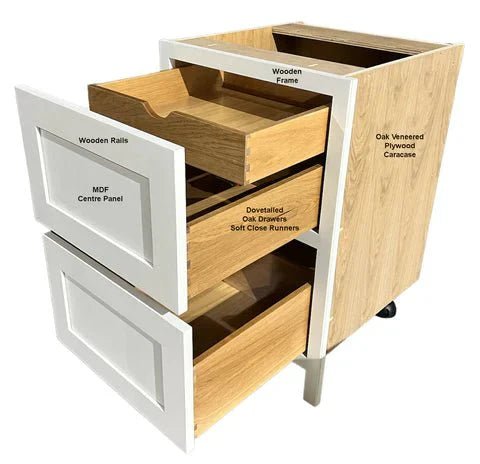
The Backbone of Excellence - Ply V MDF
Share
When it comes to crafting a kitchen that not only looks stunning but also stands the test of time, the choice of materials for the kitchen carcass plays a crucial role. Two popular options that often find themselves in the spotlight are plywood and medium-density fibreboard (MDF). In this exploration, we'll delve into the strength and benefits of a plywood kitchen carcass, highlighting how it outshines its MDF counterpart in durability, versatility, and overall performance.
- Structural Strength:
Plywood takes the lead when it comes to structural strength. Composed of multiple layers of wood veneers that are glued and pressed together with grains running perpendicular to each other, plywood boasts exceptional strength and stability. This construction minimizes the risk of warping, swelling, or splitting, making plywood an ideal choice for the rigid structure of kitchen carcasses. MDF, while sturdy, lacks the layered composition of plywood, making it more prone to damage in certain conditions.
- Durability and Longevity:
Durability is a hallmark of plywood. Its layered structure contributes to its ability to withstand the rigors of daily kitchen use. Plywood is less susceptible to moisture damage than MDF, making it a superior choice for areas prone to humidity and spills. Additionally, plywood is less likely to sag or warp over time, ensuring the longevity of your kitchen cabinets.
- Versatility in Design:
Plywood's versatility extends beyond its structural benefits. It is well-suited for intricate designs and customization. Plywood's strong edges allow for various joinery techniques, including dovetail and dado joints, enhancing the overall craftsmanship of the kitchen carcass. MDF, being denser and less forgiving in terms of joinery, may not offer the same level of design flexibility and precision.
- Weight Considerations:
While both plywood and MDF are relatively lightweight compared to solid wood, plywood strikes a balance between strength and weight. Plywood's layered composition ensures a sturdy carcass without unnecessary heft. This can be advantageous during installation and for overall kitchen weight considerations. MDF, being denser, may be heavier and more cumbersome in certain applications.
- Environmental Considerations:
Plywood often scores well in terms of environmental sustainability, especially when sourced from responsibly managed forests. The use of natural wood veneers in plywood contributes to its eco-friendly profile. MDF, on the other hand, involves the use of wood fibres, wax, and resin binders, which may not be as environmentally friendly in certain manufacturing processes.
- Resistant to Swelling:
Kitchens are exposed to varying levels of moisture and humidity, making resistance to swelling a valuable trait. Plywood, with its cross-grain structure, is inherently more resistant to swelling than MDF. This feature is particularly advantageous in areas like kitchens where the potential for moisture exposure is high.
In Summary:
While both plywood and MDF have their merits, the strength and benefits of a plywood kitchen carcass shine through in terms of structural integrity, durability, versatility, weight considerations, and environmental sustainability. Investing in a plywood kitchen carcass is not just a choice for today; it's a commitment to a kitchen that will withstand the test of time, providing a solid foundation for the heart of your home.
